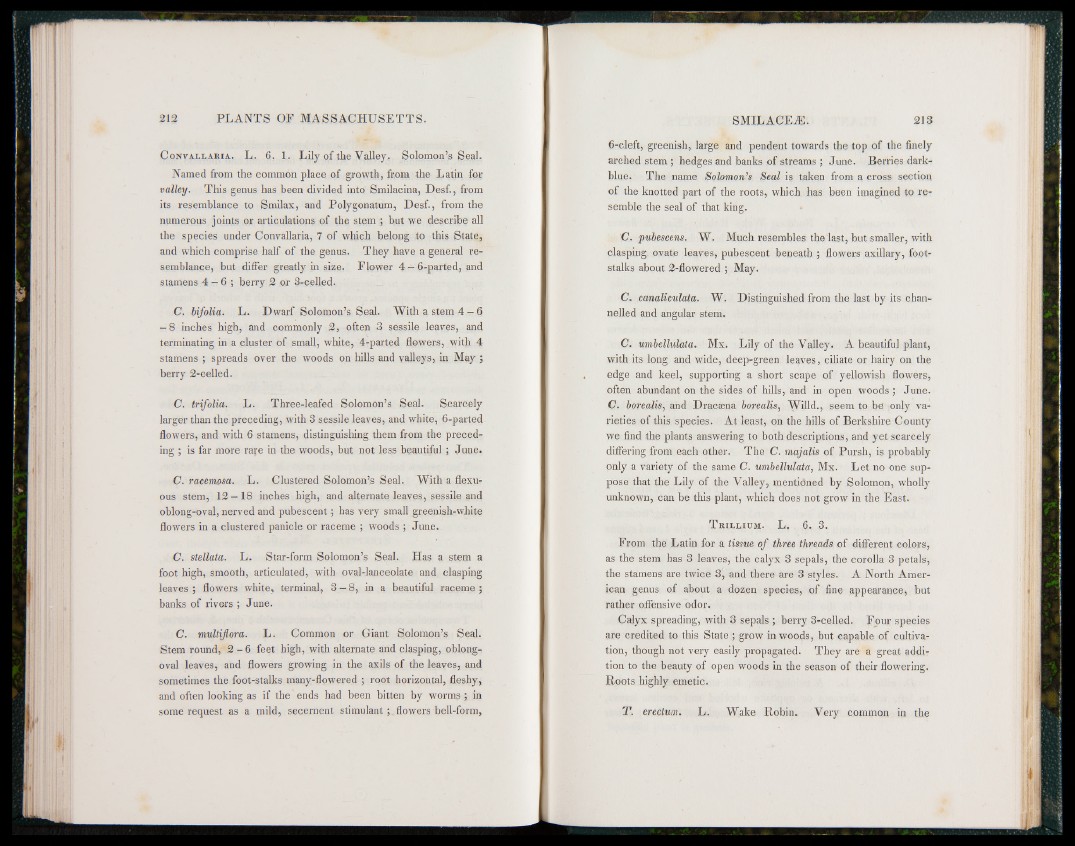
C onvallaria. L. 6. 1. Lily of the Valley, Solomon’s Seal.
Named from the common place of growth, from the Latin for
valley. This genus has been divided into Smilacina, Desf., from
its resemblance to Smilax, and Polygonatum, Desf., from the
numerous joints or articulations of the stem ; but we describe all
the species under Convallaria, 7 of which belong to this State,
and which comprise half of the genus. They have a general resemblance,
but differ greatly in size. Flower 4 — 6-parted, and
stamens 4 — 6 ; berry 2 or 3-celled.
C. bifolia. L. Dwarf Solomon’s Seal. With a stem 4 —6
— 8 inches high, and commonly 2, often 3 sessile leaves, and
terminating in a cluster of small, white, 4-parted flowers, with 4
stamens ; spreads over the woods on hills and valleys, in May ;
berry 2-eelled.
C. trifolia. L. Three-leafed Solomon’s Seal. Scarcely
larger than the preceding, with 3 sessile leaves, and white, 6-parted
flowers, and with 6 stamens, distinguishing them from the preceding
; is far more raye in the woods, but not less beautiful ; June.
C. racemosa. L. Clustered Solomon’s Seal. With a flexu-
ous stem, 12—18 inches high, and alternate leaves, sessile and
oblong-oval, nerved and pubescent; has very small greenish-white
flowers in a clustered panicle or raceme ; woods ; June.
C. stellata. L. Star-form Solomon’s Seal. Has a stem a
foot high, smooth, articulated, with oval-lanceolate and clasping
leaves ; flowers white, terminal, 3 — 8, in a beautiful raceme ;
banks of rivers ; June.
C. multiflora. L. Common or Giant Solomon’s Seal.
Stem round, 2 - 6 feet high, with alternate and clasping, oblong-
oval leaves, and flowers growing in the axils of the leaves, and
sometimes the foot-stalks many-flowered ; root horizontal, fleshy,
and often looking as if the ends had been bitten by worms ; in
some request as a mild, secernent stimulant flowers hell-form,
6-cleft, greenish, large and pendent towards the top of the finely
arched stem ; hedges and banks of streams ; June. Berries dark-
blue. The name Solomon’s Seal is taken from a cross section
of the knotted part of the roots, which has been imagined to resemble
the seal of that king.
C. pubescens. W. Much resembles the last, but smaller, with
clasping- ovate leaves, pubescent beneath ; flowers axillary, footstalks
about 2-flowered ; May.
C. canaliculata. W. Distinguished from the last by its channelled
and angular stem.
C. umbellulata. Mx. Lily of the Valley. A beautiful plant,
with its long and wide, deep-green leaves, ciliate or hairy on the
edge and keel, supporting a short scape of yellowish flowers,
often abundant on the sides of hills, and in open woods ; June.
C. borealis, and Dracaena borealis, Willd., seem to be only varieties
of this species. At least, on the hills of Berkshire County
we find the plants answering to both descriptions, and yet scarcely
differing from each other. The C. majalis of Pursh, is probably
only a variety of the same C. umbellulata, Mx. Let no one suppose
that the Lily of the Valley, mentioned by Solomon, wholly
unknown, can be this plant, which does not grow in the East.
T rillium. L. 6, 3.
From the Latin for a tissue of three threads of different colors,
as the stem has 3 leaves, the calyx 3 sepals, the corolla 3 petals,
the stamens are twice 3, and there are 3 styles. A North American
genus of about a dozen species, of fine appearance, but
rather offensive odor.
Calyx spreading, with 3 sepals ; berry 3-celled. Four species
are credited to this State ; grow in woods, but capable of cultivation,
though not very easily propagated. They are a great addition
to the beauty of open woods in the season of their flowering.
Roots highly emetic.
T. erectum. L. Wake Robin. Very common in the